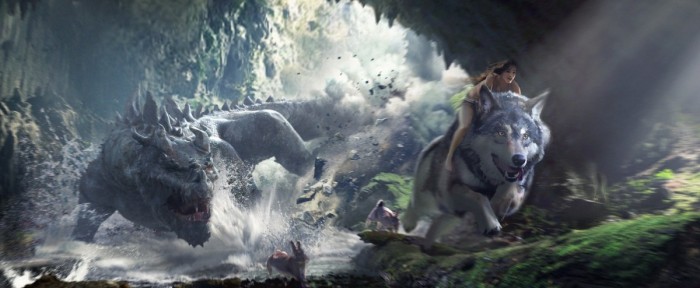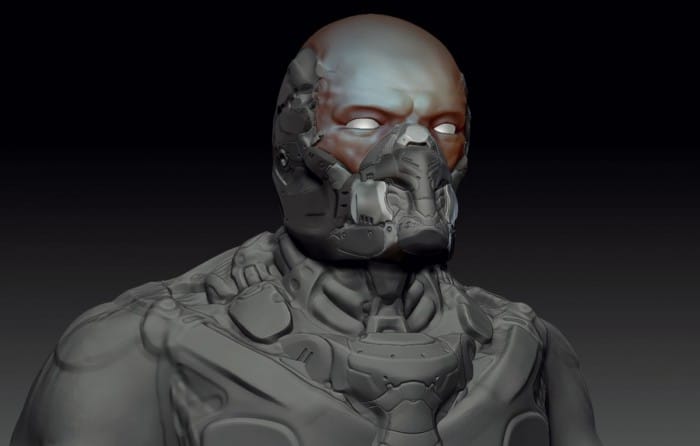This article is the first of an editorial series of Expert Talks by Virtuos, aimed at sharing the learnings and best practices in global game development and art production. In this instalment, Nicodemus Mattisson, Director of Virtuos’ Concept Art Team, talks in-depth about how to balance the common conundrum between artistic expression and project efficiency.

“Playing tag with Old One Eye” by Nicodemus Mattisson
As concept artists, we use the world around us for inspiration and try to find new and interesting ways of re-assembling these inspirations and sources into content that engages players and viewers emotionally. Whether that is designing the airlock on a space station quietly orbiting an alien planet in a game or the empathetic sidekick teddy bear holding your hand through a dark forest in a movie. Or perhaps a combination of all of that.
In crafting new worlds and the characters that populate them, the rule you’ll hear from any seasoned designer is not too deviate too far from the things you know. Your knowledge forms your understanding of the world and makes it relatable to you in meaningful ways. Some forms of knowledge are highly individual while others are universal, giving us as designers crucial tools in forging experiences that engage.
Skill, Practice, and Feedback
Working to create these kinds of experiences takes skill, practice and consistent feedback and one of the things that designers of other types of media often overlook is the collaborative nature of game development where many disciplines come together to mesh graphics, code, sound and input together.
These are vastly different disciplines of work and understanding the larger framework they support and the limitations they pose on you as a designer is of great importance for seeing the original vision through.
In recent years Virtuos has championed a position known as “Closing the gap“. This is a holistic approach to the work of crafting worlds and assets by closely emulating the production practices of the department or client we support.
One example would be our heavy emphasis on 3D tools, allowing 2D artists to construct their sketches in 3D for perfect linear perspective or using a standard body 3D mesh with some sculpting and poly-painting on top, to quickly visualize the shape and colour of a clothing piece or armour with perfect anatomical precision.

WIP 3D Model of “Stroggs 2016” by Nicodemus Mattisson
Painters Become 3D Artists
Production tools have become increasingly simple to use for the past fifteen years, so that even a classically trained painter can create complex materials and apply them to a 3D model with ease, with the abundance of ever-increasing compatibility. There was a time where digital painting was just transitioning into interest by traditional painters. Online forums and blogs filled up with great artwork, but it took quite some time for the community to accept new workflows and ideas of improving upon the efficiency of the methods which they were using.

Final Concept Artwork of “Stroggs 2016” by Nicodemus Mattisson
It is this very mindset that has been nurtured in the Concept Department, in allowing our artists to train both as 2D artists brushing up on their fundamentals while also understanding how to effectively use 3D and rendering software to aid in production. The positive effects are apparent; It brings artists closer to 3D pipelines and offers the ability to hand over a rough model of work to the 3D artists, saving time and effort for everyone involved in the asset pipeline.
It also allows for artists to focus on what is relevant and not be interrupted in their flow of ideas. Through empowering artists who might find a particular fundamental skill tough to wrap their heads around or time-consuming, it provides them the opportunity to not only bypass the complexity of drawing it but also to experiment with designs, produce variations and deliver something with a higher degree of accuracy.
- Find more about Virtuos, please visit: www.virtuosgames.com
and our Artstation: www.artstation.com/virtuosgames - For business inquiries, please contact: [email protected]
About Virtuos
Founded in 2004, Virtuos Holdings Pte. Ltd. is a leading videogame content production company with operations in Singapore, China, Vietnam, Canada, France, Japan, Ireland, and the United States. With 1,600 full-time professionals, Virtuos specializes in game development and 3D art production for AAA consoles, PC, and mobile titles, enabling its customers to generate additional revenue and achieve operational efficiency. For over a decade, Virtuos has successfully delivered high quality content for over 1,300 projects and its customers include 18 of the top 20 digital entertainment companies worldwide. For more information, please visit www.virtuosgames.com.
About Nicodemus Mattisson
Serving as Concept Art Director at Virtuos in the wonderful city of Chengdu. With broad knowledge in concept art, matte painting, and art production work, Mattisson has worked in the game industry for about 14 years serving from high-profile AAA clients to indie studios visual benchmarks and assets for their interactive products and animation.

